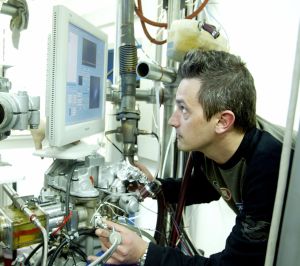Research at KIT is paving the way for tomorrow’s mobility. At the KIT Mobility Systems Center, innovative technologies and concepts are developed for the transportation of passengers and goods. On the occasion of the 2011 Baden-Württemberg Automobile Summer, KIT will present selected activities. It is started with research in combustion engines by the Institut für Kolbenmaschinen (IFKM). Increasing the efficiency and reducing emissions are major objectives of the work on gasoline and Diesel engines.
Combustion engines as powertrains for vehicles will dominate also in the future. Further development of the combustion engine can contribute decisively to reducing resources consumption and protecting the climate, explains Professor Ulrich Spicher. According to the head of the Institut für Kolbenmaschinen, evaluation of mobility concepts has to consider the vehicle as an integrated system under real operation conditions. IFKM research focuses on improving combustion processes to increase the efficiency and reduce fuel consumption and pollutant emission.
In the opinion of Ulrich Spicher, the efficiency of Otto engines may be increased from currently an average of 25% in today’s vehicles to nearly 40%. IFKM scientists are working on increasing the injection pressure of Otto engines by direct injection and stratified mixture preparation. In the vicinity of the spark plug, an ignitable mixture exists, while the remaining combustion chamber is filled with a lean, hardly ignitable mixture only. “In this way, the mixture becomes more compact and homogeneous, the fuel vaporizes more rapidly, and combustion takes place more homogeneously and faster,” says Professor Spicher.
Work under a subproject of the Collaborative Research Center (SFB) 606 “Non-stationary Combustion” is aimed at increasing the injection pressure up to 1000 bar in order to improve stratified mixture preparation and combustion. The scientists wish to reduce CO2 emissions by 50% and fine dust emission below the mass and particle number limits that will be valid from 2014. However, conventional fuel injection pumps for direct injection of fuel so far have been limited to 200 bar and do not withstand such high pressures. Within the framework of the SFB 483 “Highly Loaded Sliding and Friction Systems Based on Engineering Ceramic Materials”, IFKM scientists develop durable pumps based on ceramic materials like silicon carbide or sialones.
Diesel engines with direct injection already reach a relatively high efficiency. Their problems, however, are the soot and nitrogen oxide emissions. IFKM studies possibilities of reducing these emissions directly in the combustion chamber of the engine, for instance, by spatial separation of pre-injection and main injection: Within the framework of the DFG-funded project “Development of a New Injection Strategy for Low- soot Combustion in Diesel Engines with Direct Injection”, the researchers use two injectors. As a result of this spatial separation, the pre-injection fuel is combusted in another area of the combustion chamber than the main injection fuel. The local air/fuel ratio for main combustion is not reduced. “With this method, we have succeeded in reducing soot emissions by 80%, as a result of which nitrogen oxide emissions decreased as well,” explains Professor Spicher.
The Mobility Systems Center pools KIT activities relating to vehicle technology. Presently, 37 institutes with about 800 employees on KIT Campus North and Campus South are working on methodological and technical fundamentals for tomorrow’s vehicles. It is their objective to develop energy-efficient, low-emission, and safe vehicles and mobility concepts. Research also covers the complex interactions of vehicle, driver, traffic, and society.
Under the heading of “Future Mobility”, KIT will present its scientific activities on its new “Campus East – Mobility and Innovation” during an Open Day on July 02. More information can be found at: http://www.pkm.kit.edu/english/3072.php.
Prior to the Open Day, Karlsruhe Institute of Technology increases its efforts to inform the public about activities of the KIT Mobility Systems Center. More information can be found at:
http://www.kit.edu/mediathek/print_forschung/Broschuere_Mobilitaetssysteme_en.pdf
Being “The Research University in the Helmholtz Association”, KIT creates and imparts knowledge for the society and the environment. It is the objective to make significant contributions to the global challenges in the fields of energy, mobility, and information. For this, about 10,000 employees cooperate in a broad range of disciplines in natural sciences, engineering sciences, economics, and the humanities and social sciences. KIT prepares its 22,800 students for responsible tasks in society, industry, and science by offering research-based study programs. Innovation efforts at KIT build a bridge between important scientific findings and their application for the benefit of society, economic prosperity, and the preservation of our natural basis of life. KIT is one of the German universities of excellence.

